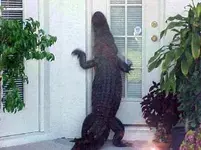'Nuisance hunter' pulls gators from city oxidation pond
Friday, June 6, 2008 4:03 PM CDT
PONCHATOULA - From 20 to 30 yards off, Michael Fannaly can see that he has an alligator on his line.
The line is taught, sometimes moving back and forth in the water of the City of Ponchatoula's oxidation pond.
Fannaly stops his pickup truck on the pond's levee and gets out. He retrieves a long aluminum pole with a small shepherd's hook on the end from the truck bed. Using the pole and hook, he brings the line to within reach. Then, he begins pulling the alligator toward the levee.
He's careful because he doesn't want to be pulled off balance and into the pond. The side of the levee is almost vertical. The pond is also rather deep right up to the edge, two conditions Fannaly doesn't want to deal with while trying to land a large, fighting gator.
The city has hired Fannaly, a professional “nuisance hunter” from Ponchatoula, to remove some of the alligators from the oxidation pond. The gators can become aggressive, making it difficult for city employees to work around the pond. Mayor Bob Zabbia said a worker reported recently that what appeared to be about a 12-foot gator took a chomp at his truck tire.
The city must first receive permission from the state Department of Wildlife & Fisheries to harvest the gators. That's usually not difficult if the reason is legitimate, such as an endangerment to city workers.
Fannaly's pay is from the sale of the hides.
He has been a nuisance hunter for about 35 years. He also hunts nutria under a federal program but says 99 percent of his work is with alligators. He said he has been getting calls recently from the Loranger and Independence communities to remove small gators from the ponds of property owners.
He has been designated a nuisance hunter by the WL&F department for Region 7, which includes Tangipahoa, St. Helena, St. John the Baptist and Livingston parishes. Qualifications are based primarily on experience and the ability to handle the gators.
The largest gator Fannaly has tangled with was a 13-foot one-inch beast caught in the Maurepas Swamp several years ago. During his 35 years as a nuisance hunter and working in the swamps, he said he has never had a really close call with any of the reptiles.
“This looks like about an eight footer,” Fannaly shouts to Zabbia as he pulls the gator toward the levee.
Fannaly uses beef melt on an alligator hook as bait. The bait is suspended on a hook and line from a pole just above the water's surface and left overnight.
When he has pulled the gator near the bank, he uses a .22 caliber rifle to dispatch it. He then pulls it to the top of the levee.
One of Fannaly's first moves after landing the gator is to tag it, which is required under state law.
He then puts the gator in the bed of his pickup.
Looking out over the pond, he points to a couple smaller gators, their eyes just above the water's surface.
Fannaly said the gators find a home in the pond because the dining is pretty good. Snakes, nutria and water fowl make for good eating with a minimal effort.
Considering that the oxidation pond is enclosed by a chain link fence, Fannaly was asked how the gators get in.
“They climb the fence,” he said, seriously.
He said it's nothing for an alligator to climb a fence to get into a pond, even when the fence is topped with three or four strands of barbed wire at a 45-degree angle.
Zabbia signed the official state paperwork verifying Fannaly's harvest for the day. Fannaly then set about baiting hooks for the next day.
He will arrive early in the morning to see if he will make any money that day.



 I have never seen that...
I have never seen that... 



